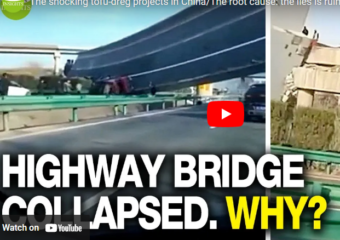Uncategorized
The Hubei Bridge Collapse

This is not as interesting as some of the other things that have emerged from Wuhan in the past couple of years. . The Hubei Bridge Collapse will let us go through the thought process of cause analysis. This will let us better think about why this happened.
Here is the video:
Let’s start with a problem statement. The problem statement is, that the bridge collapsed. We don’t have any unfiltered information about the details of this. We do have a fairly obvious video that states that it did happen. Unfortunately we’re living in a world where unfiltered information is very difficult to come by. This is especially from this lovely country, where I have been a couple of times.
But that’s all we need at the moment, just the facts. The bridge collapsed.
This is a bit of a thing over there, and also over here. The “Tofu-Dreg” concept is that a lot of these gleaming buildings over there are constructed to look good for about a year, and then fall apart. According to a different resource, there have been 37 bridge collapses in China over the last five years. That’s about 7 per year, or one every couple of months. The Hubei Bridge Collapse falls into that category.
Additional Information
There is an article below that says that some of this is weather and earthquake related.
I have included a reference below from Reuters discussing this specific incident, which happened in December of 2021.
However, bridge collapses happen all over, including the one that happened in Florida a couple of years ago, one that recently happened in India, and in Genoa, from the friendly nation of Italy.
Bridge construction is difficult. You’re asking to defy gravity, and very often, you’re asking to do so for a period of many decades or centuries. The Romans had this more or less figured out 2000 years ago, and some of those bridges are still standing because of their construction brilliance.
In China there is an epidemic of the “Tofu-Dreg” projects, in which something is built in the cheapest fastest way possible, and then falls down shortly after the ribbon cutting.
So difficulty vs. corruption. That’s an apparent underlying cause.
The Precipitating Incident
The Precipitating Incident, which is the immediate cause of the problem: Four heavily overloaded trucks were driving over this thing at the same time, and the combined weight was thought to exceed the bridge’s carrying capacity.
Why Did This Happen?–Cause Analysis
Let’s not use the “Five-Why” analysis in this case because it is too simplistic. I believe Fault-Tree analysis is better. Let’s break it into four parts: Human, Procedure, Resource and Detection
Human Factors
With regard to the proximate cause, it is mainly about the four truck drivers that tried to drive over that thing at the same time, with overloaded trucks.
We’re after the answer to seemingly simple question: Were the drivers good or not good?
We don’t know, of course. It would be pretty easy to jump to the conclusion, without facts, that the truckers were just some people off the street, who were doing what they were told.
So, if we were investigating this, the first thing we would do is pull the drivers’ training records and licensing. This is one of the reasons that training records are a required part of ISO registration. You have to be able to prove you did something right. In this case, if we had found out that the drivers were trained, and fully aware of the overload condition, and also fully aware that the bridge would collapse, we could point the finger at the drivers.
In the US it is part of the drivers’ responsibility to know how much their truck weighs among other things.
There is still an underlying question of “human factors” as well. Were one or more of them loaded, sleep deprived, or in an emotionally unsuitable state for driving an overloaded truck? Over here we have rules on all of these things for this very reason.
Procedure Issues
Well, there were three elements to the process, to the extent we can tell. There is the procedure for loading the truck, and a procedure for driving the truck.
Also there may be an additional procedure for inspecting the truck at some point, which we will address in the “detection” phase.
If what the article says is true, and these trucks were overloaded, that’s violation #1. Valuation #2 is that the drivers didn’t refuse to haul the weight, although that is a bit of an issue. Nobody, particularly in that country, wants to be a hero and refuse to do work. Here, both the driver and the company may be held legally responsible for driving an overweight truck, per the article I have linked below
Truck Driving Procedures
As to driving the truck, here in the US there is a system that requires bridges to be “rated” for weight. One of the “infrastructure” things we are hearing about is the fact that a lot of these were built a long time ago, and what was once a lonely little bridge out in the country may find itself at the foot of one of those big automotive plants someplace, and usually there is a program to upgrade the bridge in cases like that. There may also be deterioration, for example the bridge that collapsed in Minnesota a few years ago after salty water penetrated down to the rebar level.
None of this is infallible, however, and a trucker driving an overloaded truck across a rickety bridge is a scene that is sitcom-worthy.
So if we were looking for the root cause, which we started out doing, there is probably something in here that was a failure.
The Resources
We talked about this above, one resource is the truck, and the other the bridge.
The truck is rated to haul a given weight safely. In the US that information comes with the truck and/or captured when you register it with the state. The maximum weight limit for the road is 80,000 pounds GVW for interstate highways. Can you engineer a truck that can haul more than that?
This is, of course, determined by a lot of bright engineers, and is based on theoretical maxima.
Does that mean that people don’t overload them anyway? The interaction of the procedure and the resource is important here.
In this crazy time, where individual freedom takes a high priority and there is an ongoing resistance to regulation, sometimes regulations make sense, and here in the US there are inspections and weighing to confirm that people don’t exceed the maximum allowed vehicle weight.
The Bridge Itself
The same can be said for the bridge. In the USA there is a big information network, particularly on the interstate highways, to make sure the bridges are capable of holding a known weight. When these things are constructed in the first place, as part of the planning process, the weight capacity is engineered into them, and there are inspections and verifications that confirm that the concrete is correctly formulated.
There is also on-site testing and various tests that are conducted throughout construction to make sure that the supply of materials is consistently meeting the engineered specifications.
Do things happen anyway? Well an example of this is the collapse of the Surfside Condo down in Florida, which killed a few people in January of 2021. In this particular case, there was deferred maintenance, causing concrete fractures, and leading to a major disaster. So I guess you would say that there were engineering issues, but also detection issues.
Detection
That does lead us to the detection phase, There were multiple failures in detection, or the Hubei Bridge Collapse probably wouldn’t have happened.
The Detection Phase
And, in each of these systems we have talked about above, there is documentation. This includes the truck driver and the bridge, and if a collapse like that happened in the US the first thing to do would have been to pull the records and find out where the inspection steps were skipped.
Each one of these inspection steps, by the way, is also an opportunity for corruption. Anybody sufficiently determined would be able to bribe their way through inspections in some places.
I did an audit a few years ago in a place where they make the highway guard rails. This client was required to retain production documents for several decades, in case there was some legal case regarding the failure or lack of failure of one of their guard rails.
So at the high level one of the possible failures on this is the “record retention.” If the several organizations in this process (trucker, truck manufacturer, truck owner/shipper, bridge builder, bridge inspector) had terrible record retention, an investigator might have had a hard time getting to the bottom of it. That’s why in the ISO world people pay attention to those things.
What we’re talking about here is alarm systems. There are many different types of alarms, including the ones that make noise and the ones that come in the form of a report. When alarm systems and feedback systems break down, it is very problematic.
Hubei Bridge Collapse
At some point in the day, nothing happens in isolation. We have said that all along as it applies to complex systems. Chances are, if one part of this system is terrible, a lot of the system is terrible. This includes the detection systems. In this case, there are the additional external and internal issues as well. The whole country is on a massive construction program. People are rated on how much they can build, and not on how well. Everything is rushed. There are scarce resources. There is an organizational priority placed on fast, rather than good.
This is a small example of the worst case scenario. Multiple organizations and multiple failures are involved and it leads to disaster.
Links and References:
Contact me for source information
https://www.mdpi.com/2071-1050/12/3/1205/htm
![]()










